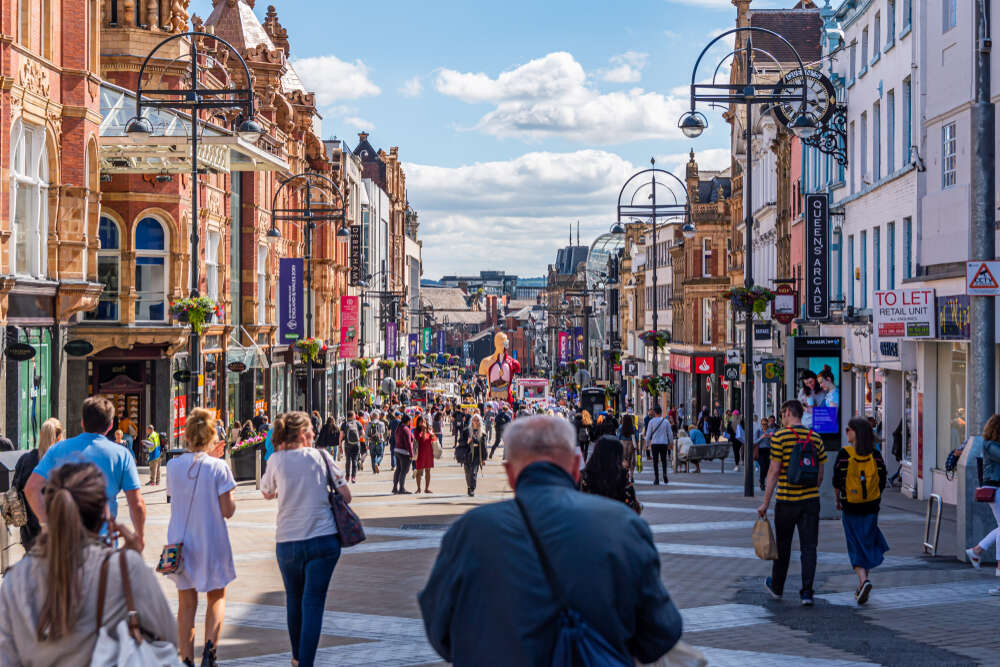
There are a number of ways of defining city populations, and thus the ‘largest city in Britain’ of which perhaps the most obvious is the “urban area” – that is, the continuously built-up zone. This, after all, is the thing that feels like a city when you are actually inside it – or, come to that, when you are flying over it.

The most up-to-date stats on this measure come from Demographia, a St. Louis-based consultancy, which every year gathers data on every city with a population of 500,000 or more and ranks it in its World Urban Areas Report (updated for 2023).
Demographia lists the UK’s most populous urban areas as:
- London – 10,803,000
- Birmingham – 2,517,000
- Manchester – 2,449,000
- Leeds-Bradford – 1,659,000
- Glasgow – 1,100,000
- Southampton-Portsmouth – 805,000
- Liverpool – 835,000
- Newcastle – 719,000*
- Nottingham – 719,000*
- Sheffield – 603,000
A number of comments about this data. Firstly, on this definition, Britain’s historic second city Birmingham has actually kept its place.
Secondly, the only one of the four UK countries without a city of this size is Wales: Cardiff, with 488,000 residents, just misses the ranking.
Perhaps the most unexpected entry here is in sixth place. No one would think of either Southampton or Portsmouth as a major city: considered as a single entity, though, in terms of sprawl they are, they’re bigger than relative giants such as Liverpool or Newcastle.
But there are other ways of defining cities.
Primary urban areas
Primary Urban Areas (PUAs) are, essentially, collections of local authorities that function a bit like single cities. They were created by the Department for Communities & Local Government as a statistical tool to help it draw comparisons between very different places. The aim was to come up with a list of areas less arbitrary than existing council boundaries; but that still allowed you to count largely independent but touching cities (Southampton and Portsmouth, say) as independent entities.
Centre for Cities uses PUAs in its research and lists the top ten areas – according to the latest statistics from 2021 – as:
- London – 10,257,7000
- Birmingham – 2,560,500
- Manchester – 2,517,500
- Glasgow – 1,019,900
- Newcastle – 868,800
- Sheffield – 854,200
- Leeds – 798,800
- Bristol – 753,700
- Nottingham – 685,200
- Liverpool – 653,000
Manchester is rather shrunken by this metric, while Birmingham is still in second place. Leeds, deprived of Bradford, has fallen a long way down the league tables. And Southampton and Portsmouth, two cities once again, are nowhere to be seen.
Let’s look at another definition.
Metropolitan counties
Let’s look at the populations of England’s largest metropolitan counties, per the Office of National Statistics:
- Greater London – 9,078000
- West Midlands (Birmingham) – 2,936,000
- Greater Manchester – 2,819,000
- West Yorkshire (Leeds-Bradford) – 2,314,000
- Merseyside (Liverpool) – 1,412,000
- South Yorkshire (Sheffield) – 1,396,000
- Tyne & Wear (Newcastle) – 1,125,000
…and of some of the bigger official “cities” they contain (2021 figures):
- Birmingham – 1,153,000
- Leeds – 792,000
- Sheffield – 582,000
- Manchester– 558,000
- Bradford– 532,000
- Liverpool – 494,000
- Bristol – 470,000
- Newcastle – 296,000
- Sunderland – 275,000
- Wolverhampton – 261,000
Metropolitan areas
Metropolitan areas are, in the most literal sense, the big ones – not simply a city itself, but all surrounding areas including suburbs, commuter towns and rural hinterlands. On this definition, London isn’t Greater London – it is in fact a large chunk of the Home Counties, too.
The figures below are from a document published in 2007, and are based on data taken from 2001, so the numbers are out of date (hence the inconsistencies with the other lists above). But it’s the best we’ve got so here, courtesy of the EU’s ESPON project, are the top ten.
- London – 13,709,000
- Birmingham-Wolverhampton – 3,683,000
- Manchester – 2,556,000
- Leeds-Bradford – 2,302,000
- Liverpool-Birkenhead – 2,241,000
- Newcastle-Sunderland – 1,599,000
- Sheffield – 1,569,000
- Southampton-Portsmouth – 1,547,000
- Nottingham-Derby – 1,543,000
- Glasgow – 1,395,000
Considered as a metro, rather than a city, Birmingham is way ahead of Manchester – a result of its better transport links to surrounding towns, perhaps. The twin cities of South Hampshire are back in the rankings, and several other cities look a lot bigger when the whole of their economic footprint is taken into account.
Glasgow, however, does not: it barely makes the top ten. Compared with cities like Birmingham or Leeds, it doesn’t have much of a hinterland.
Towards a conclusion
What should be clear by now is that no definitive ranking is possible. You can say that London is definitely the UK’s biggest city, and realistically everyone will accept it as gospel. You can say that Manchester is bigger than Newcastle, and be on pretty safe ground. But is Manchester bigger than Birmingham? The answers suddenly begin to become less clear.
What we can do, though, is come up with a sort of typology: not a numbered ranking, exactly, but a way of visualising which league cities are playing in.
Here you go:
- Megacity: London
- Second cities: Birmingham, Manchester
- Major cities: Glasgow, Leeds, Liverpool, Newcastle, Sheffield
- Large cities: Belfast, Bristol, Nottingham, Southampton/Portsmouth, Leicester
The latter category is incomplete: other cities, like Cardiff, Edinburgh, Middlesbrough, even Brighton or Bournemouth, probably have a claim to be in there, too. Britain only has one city whose population even hits 10 million, but a couple of handfuls of them are bobbing around the 500,000 mark.
[Read more: Where are the largest cities in the US?]






